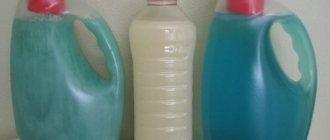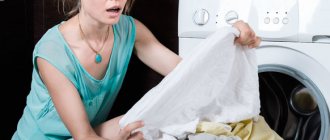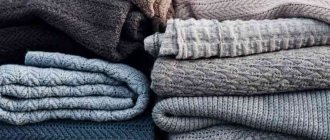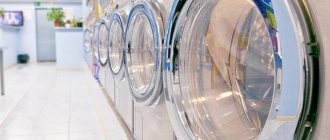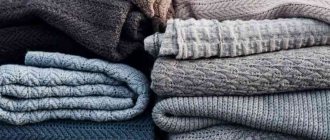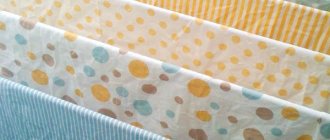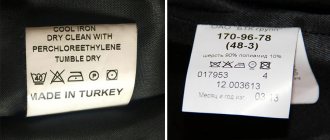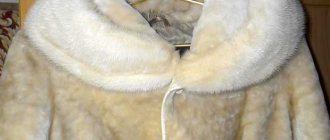Material properties
The fabric has the following features:
- Made from natural fibers, therefore environmentally friendly.
- Has antistatic properties.
- Breathability - thanks to the porous structure, oxygen is easily transported through it, which allows the skin to breathe.
- It has antiseptic characteristics; mold or mildew does not appear on it.
- Good thermal conductivity. The outfit is recommended to be worn in hot weather. Matter keeps the temperature of the human body within comfortable limits.
- Wear resistance. A robe made from such fabric lasts for years.
Features of fabric behavior when washing, choice of temperature and detergents
Despite the large number of positive aspects, this type of material has a significant drawback. Often, when washing, it shrinks so much that the situation cannot be corrected. But this only happens if all recommendations have not been followed.
There are nuances, knowing which you can clean the product without negative consequences:
- Linen washing should be done in warm water (no more than 30 degrees);
- the manual process requires the use of a large amount of liquid;
- It is recommended to wash colored materials with special products for such fabrics;
- The use of chlorine-containing bleaches is strictly prohibited.
You can find out whether linen shrinks when washed in another way - wet a piece of fabric sewn on the wrong side of the product and see its reaction to the product.
Washing linen in a washing machine
Washing in a machine is the most convenient and fastest way to care for things made of natural fabric. True, there is one nuance that must be taken into account: plant fibers strongly absorb water.
Therefore, it is recommended to wash linen items separately from other clothes, and load the drum 2/3 full. Then the detergents will be rinsed out better, and the products will be less wrinkled.
Which mode to choose
If there are no washing recommendations on the product label, then you should adhere to the following rules:
- bed linen: white – “cotton and linen”, “linen”, “boiling”; colored – “linen” at temperatures up to 60°C.
- clothes made of fine linen, mixed fabrics - delicate (hand) wash, "wool".
- things made from coarse colored linen - “cotton”, “flax”.
Note! Linen fabrics wrinkle easily, so it is not recommended to machine spin them.
Things are taken out of the drum and immediately hung on hangers or a rope so that the flowing water itself levels the fabric.
If you cannot do without spinning, then it is better to carry out the operation at the minimum speed - 400-500 rpm.
Advantages and disadvantages
Machine wash should be chosen for items made of thick linen, white or with persistent coloring. If all recommendations are followed (temperature, mode, detergent), clothes and linen will delight you with quality and aesthetic appearance for a long time.
But if the item is made from the finest fabric, decorated with colored embroidery, sequins or beads, it should only be washed by hand.
Then there is a greater chance that the clothes will wash well, and the decor will not cut the fabric or fade. In addition, when washing by hand, there are fewer complex creases and bruises.
For new products, there is an unspoken rule of care: even if there is a symbol on the tag that allows washing in a machine, you must wash it by hand the first time.
This will help you understand how the fabric reacts to water temperature, whether it sheds and how much it shrinks. Then it will be easier to decide on the choice of mode and detergent.
Selecting the type of wash
In most cases, housewives choose an automated process. Their desire is understandable, since there is no need to waste time and effort to wash away stubborn dirt. But unfortunately, this is not the case. Linen is a rather capricious material.
It is better to wash it by hand, because serious mistakes are often made, which is why the outfit shrinks hopelessly. The label sewn on the reverse side will tell you how to wash linen - by hand or in a machine.
Important: the automated process is permitted only for those products that have a corresponding mark on the tag.
Washing linen items: temperature and shrinkage
Durable linen fabric is very resistant to washing at high temperatures, and is not even afraid of the boiling process. But don’t rush to rejoice and throw your linen clothes into boiling water with a light heart. All natural fabrics, without exception, shrink slightly when exposed to hot water.
Instructions for washing shirts at home: manually and in a washing machine. Read the article about how to properly wash cross stitch so as not to spoil it.
About washing polyester clothes in a washing machine and by hand - follow the link https://kakpostirat.ru/kak-stirat-poliester-v-stiralnoj-mashine.html
Does linen shrink when washed and how much? A natural linen shirt will shrink by at least 5% after boiling, which means that the item will become one size smaller. Flax with synthetic admixtures shrinks less, but also tolerates temperatures of 90–100 degrees much worse. After the fifth boil, the semi-synthetic material will become thinner until the fabric breaks.
Good to know
Before choosing a temperature for washing linen, you need to determine the quality of the material. Natural linen has natural shades, it is cool and smooth to the touch, and does not tend to wrinkle. If visual inspection of the fabric is not enough, set fire to the linen thread. Only ash will remain from the natural thread, the mixed material will melt.
If the newly purchased clothes are too big for you, you can artificially make them smaller by washing:
- At what temperature should linen be washed so that the shrinkage reaches the coveted five percent, equal to a reduction of one size? Maximum shrinkage of the material can only be achieved by boiling and subsequent drying near heating devices.
- Linen shrinks by 2 - 3%, which corresponds to a decrease of half a size when washed in automatic mode at 800 rpm. The water temperature should be at least 80 - 90 degrees. A similar effect can be obtained if boiled flax is carefully straightened and dried in cool air.
- The minimum shrinkage of 1% is almost unnoticeable and can occur when washed at temperatures ranging from 60 to 80 degrees.
Warning!
In pursuit of reducing the size range of clothes, you should not get carried away with washing linen by boiling and cleaning at a very high temperature. No matter how durable linen is, if it is constantly subjected to aggressive washing, the natural fibers will become thinner.
Wash by hand
This type is most preferable for delicate fabrics, since during the process you can control the reaction of the material to the selected product.
Mode of application:
- Pour a large amount of warm water into the basin (for colored material - no higher than 30, without color - 40-50 degrees).
- If granular powder is used, you should first dissolve it in 200 ml of hot water, and then add the liquid to the container. But it is still recommended to use gel-like products, since they do not leave grains and are washed out better.
- Gently wipe the surface of the fabric to remove dirt. When washing, soft brushes or foam sponges are used.
- After the procedure, you need to rinse the linen with warm water, preferably running water. During the final rinse, add fabric softener to make the fabric softer.
Household chemicals for colored and white products
It is not difficult to find several products on sale that will take good care of linen fabrics.
"Sarma"
It is one of the gels suitable for manual process. Designed for light-colored fabrics, as it contains bleaching elements that can change the shade.
Important: before washing colored laundry with Sarma, it is recommended to check the reaction of the fabric in an inconspicuous area.
Ingredients: sulfates, carbonates, phosphates, anions, oxygen-containing bleaches, silicates, non-ionic surfactants, defoamer, phosphonates, dye transfer inhibitor, enzymes, optical brighteners, fragrance.
Efficiency: due to the high concentration of active components, it penetrates deeply into the fabric structure, washing away dirt molecules on the first try.
Release form: gel, powder.
Price: 70-250 rub.
Directions for use: add 1 tablespoon of the product when soaking, as well as into the powder compartment in the machine.
"Eared Nanny"
A delicate option for cleaning stains, which is recommended for use on children's clothes . Does not contain elements that can damage the fabric.
Ingredients: sulfates, phosphates, oxygen-containing bleaches, silicates, non-ionic surfactants, defoamer, anti-resorbents, enzymes, optical brighteners, fragrance.
Efficiency: positive results appear when washing new stains. Additional treatment may be required to remove stubborn dirt.
Release form: powder, gel.
Price: cost starts from 40 rubles.
Directions for use: Add 1 tablespoon of product to water when soaking or washing.
Sonett Sensitive
For people with hypersensitive skin, it is recommended to use household chemicals based on natural ingredients.
Ingredients: zeolite, vegetable oil soap, citrate, sugar surfactant, sodium carbonate, silicates, sodium bicarbonate, organic quillaya.
Efficiency: due to the high content of active substances, it has a destructive effect on pollution atoms, while preserving the color and texture of the fabric. The product shows good results compared to similar ones. Works best on grease stains. The only negative is that it is not always available in stores, but it is easy to purchase online.
Release form: gel, powder.
Price: varies depending on the volume from 150 to 1500 rubles.
Directions for use: add 20 grams of powder when soaking or into the vending machine compartment.
Machine washable
Since linen shrinks when washed, you should carefully choose the appropriate mode. So, the temperature should be no more than 30-40°C, the number of revolutions per minute should be 400-500. It is also advisable to select the extra rinse option to completely remove any remaining detergent from the material.
Let's look at the basic rules for washing linen items in a machine.
- The drum should be loaded no more than 2/3. If you overload it, the quality of the wash will deteriorate, and the items themselves will be severely wrinkled.
- White and colored items are washed separately; it is also important to sort multi-colored items by color, as the fabric fades.
- Even greater protection for the product can be obtained by using special covers for linen.
- If the product has colored embroidery, wash it without pre-soaking, and add salt to the rinse aid compartment.
- When rinsing colored linen items, pour vinegar (1-2 tbsp) or add citric acid into the rinse aid compartment.
It is important to remember that natural linen can shrink even with the most delicate cycle in the washing machine and following all the rules. But this can be corrected when ironing: run the iron over the product through damp gauze, folded several times.
How to wash linen in a washing machine
This process is most convenient for housewives who save their time and effort. But it is not always possible to achieve positive results.
The answer to the question of whether linen should shrink after machine washing is ambiguous, because the result depends on many factors. To avoid unpleasant surprises, you should follow certain rules:
- choose hand wash or “delicate” mode;
- set to the minimum number of revolutions;
- Wash fabrics of different colors separately from each other;
- the water should be no hotter than 30-40 degrees;
- It is preferable to use liquid or gel products.
Important: flax absorbs a large amount of moisture, so do not overload the drum. It should be about 30-40 percent full.
Directions for use (for heavy soiling):
- Dissolve the powder in 200 ml of warm water.
- Add the resulting mixture to a bowl with plenty of liquid and soak the cloth.
- After an hour, place it in the washing drum, lightly squeezing out excess moisture.
- Add product to the compartment.
- Select the required settings.
- After completing the process, dry things naturally.
For fabric that only needs to be slightly refreshed, simply wash it by adding 10-20 grams of powder or gel.
Despite the fact that this process has many nuances, the machine copes much better with contamination due to active mechanical action on the material.
Choosing a product for colored and white products
Household chemicals must meet the following parameters:
- Use washing powders without chlorine. These include children's ones, for example, “Eared Nanny ,” whose characteristics were revealed a little higher.
- It is advisable to take gel or liquid products.
- Light-colored fabric must be treated with a substance containing oxygen bleach.
- For materials with decor, as well as colored ones, it is recommended to choose special paint preserving products.
Detergents
The peculiarity of linen fabrics is that after each wash they become softer and more pleasant to the body. But only if washed with the right detergent. It should not contain aggressive components: chlorine, sulfates and other substances that damage fibers. Moreover, it is better to take liquid products, since they are more easily washed out of the fabric and therefore do not leave streaks or stains.
Undyed items can be washed well with universal powder or gel, white items can be washed with products for white laundry, colored items can be washed with paint-preserving components. If necessary, they can be replaced with laundry soap, powder (gel) for children's or delicate items.
It is recommended to bleach linen using oxygen-containing bleaches and home remedies.
Features of washing embroidery
A blouse decorated with satin stitch or a cross always stands out against the background of everyday clothes. It gives it a festive and special charm. But caring for such a unique outfit is not so easy.
It is not allowed:
- unscrew;
- boil;
- soak for a long time.
Embroidered fabrics can be washed both in a machine and by hand. The latter option is more acceptable, since in this case there is practically no risk of damage to the threads. It’s up to you to decide which option is more suitable.
Hand wash embroidery
- Fabric with stubborn dirt should first be soaked in a soapy solution for half an hour to prevent the floss from shedding.
- The use of brushes is strictly prohibited, especially when cleaning stains from the embroidery itself. Instead, it is better to take a foam sponge, which you only need to lightly rub the contaminated area.
- At the end of the procedure, rinse the product several times with plenty of water.
In an automatic car
Since washing embroidered linen in a washing machine is a risky activity, certain rules must be followed:
- use settings for delicate fabrics;
- water - no more than 30 degrees;
- before the procedure, the products must be turned inside out;
- remove the spin function.
How to wash linen items
When washed correctly, a linen shirt or other item will become even softer and more comfortable.
The easiest option is to wash the fabric yourself without using stain removers.
It is highly undesirable to use bleaches containing chlorine or other aggressive components. Bleach creates friction, which negatively affects the material. Regular laundry soap is ideal; you need to apply it in the required amount and soak the items in the soapy solution for half an hour.
To prevent things from becoming wrinkled, add fabric softener, however, natural linen will still not look perfect.
You can wash linen correctly in a washing machine, if you observe the temperature conditions and other add-ons.
How to wash linen in a washing machine
The rules for machine washing linen clothes are based on a delicate attitude towards the fabric:
- Regular washing powder is not recommended. It is better to give preference to powder for delicate washing or children's washing.
- Don’t forget at what temperature you can wash things in an automatic machine, and see if there is an authorization icon on the label. The temperature regime for colored clothes should not exceed 40 degrees, and undyed 60 degrees.
- We turn on the machine for “hand wash” or select the delicate mode. This will be the washing mode for linen.
- Spinning should not be done at high speeds. Set the value to 400-500 rpm.
Prevention of shrinkage
Items that are entirely made of linen often shrink due to heat treatment. This occurs due to the use of hot water, incorrect choice of powder or poor material. To avoid such a situation, you should strictly follow the recommendations:
- do not exceed the permissible temperature limit;
- choose high-quality fabric (with a smooth surface, dense weave of fibers and resistant color);
- Use only products that are specifically designed for this type of fabric.
How to wash colored linen clothes in a washing machine
Rules for washing colored linen:
- Colored linen should be washed separately, as colored items may fade and stain whites.
- To maintain rich color, it is recommended to use powders for colored laundry that do not contain chlorine.
- You can use stain removers designed for colored laundry.
- Bleaching agents for colored linen are prohibited.
- Since linen absorbs moisture, there is no need to overload the washing machine; things should spin smoothly in the drum. Otherwise, the paint will appear in streaks on the fabric.
If the product is damaged
Ignorance of the characteristics of delicate fabrics can lead to significant shrinkage. If this happens, you should:
- Wash the item in warm water.
- Pull out and lightly mash to remove excess liquid.
- Dry naturally by about 80 percent.
- Spread gauze over the product and iron it with a double iron, gently stretching it from the center to the edges.
If this does not help, you need to put the clothes on yourself and wear them for several hours. This natural fabric has the ability to stretch well.
Bleaching linen products
Oxygen bleach is ideal for bleaching linen items. It is added according to the dosage prescribed on the package. The product is soaked in this solution overnight and then placed in an automatic machine.
ARTICLE FOR YOU
How to wash: leather, eco-leather, leatherette
Packaged persalt can also help if you soak flax in it along with a small amount of powder for no longer than 12 hours.
A weakly concentrated solution of acetic acid will also bleach a T-shirt or undershirt. It is necessary to soak the fabric in an enamel bath for 2-3 hours, covering with a lid. Then wash in any way.
Hydrogen peroxide is also a good whitener. Take 2 large spoons of the substance per liter of water. The product is soaked for 24 hours. The most harmless method for fabric is to use a powder with the “optical whitening” property.
Bleaching things
Washing linen to prevent it from shrinking
To prevent linen shrinkage, you need to study the quality of the purchased fabric. It’s good if the threads are woven evenly and the fibers are completely saturated with dye.
Truly high-quality flax, when properly heat treated, will never shrink. Because the responsible manufacturer first treated the fabric at boiling point before selling it.
If you have doubts about the quality of flax, then you need to adhere to the following recommendations:
- Choose the correct temperature mode (for white fabric no more than 60%, for colored fabric - no more than 40%). This way the fibers do not swell, which prevents them from coming into close contact;
- Iron the item when wet. Thus, squeezing the iron helps to forcefully stretch the fibers and fasten them in the desired shape.
It is also better to dry flax in a vertical position, so that its own gravity does not allow the linen to shrink.
Washing linen to help it shrink
When washed, any linen item will decrease in size if it contains at least 10% synthetic fibers. Therefore, you won’t have to do anything special for shrinkage.
Linen can shrink even if the product is manufactured by a low-quality manufacturer who did not heat-treat the fabric before selling it. It is impossible to achieve special shrinkage of 100% natural flax even when boiling it. The result will only be damage to the fabric pattern and its colors.
ARTICLE FOR YOU
How to wash bouclé items: in the washing machine and by hand
If there are doubts about the quality of linen, it is enough to violate the temperature range during washing described above, and the linen will shrink. Also, to shorten it, you can dry the fabric horizontally and iron it only after it has completely dried.
Removing stains
Like any other material, linen can receive a variety of types of contamination. There are general rules for cleaning stains:
- Clean in warm (not hot) water.
- Fresh stains are easier to remove.
- It is recommended to first use any product on an inconspicuous area of the material. If the color or structure changes, it must not be used.
- It is advisable to wash fabric with embroidery without bleaches or stain removers.
- When removing blots, do not use chlorine.
- Do not iron laundry if the stain is not completely removed. A hot iron will “cook” it and the blot will be more difficult to remove.
Below we will consider several options for means by which contaminants can be cleaned as safely as possible.
Laundry soap
It washes stains of almost any origin: from ice cream, coffee, tea, cocoa, berries, red wine, fish, oil and fat, juices and fruits, grass, blood, sweat, soot, rust. That is why such soap is an indispensable assistant for every housewife.
Due to the high content of fatty acids and alkalis, the product does an excellent job without damaging the color and structure of the fibers. It removes especially well new contaminants that have not yet been absorbed.
Mode of application:
- Grind the soap and dissolve it in a glass of warm water. Then add to the soaking liquid and wait about an hour. Then wash the fabric by hand or in the machine.
- Moisten the contaminated area generously with warm water and rub with the product. Let it soak for about 20-30 minutes and then wash the fabric.
Brighteners and stain removers
In this case, the principle “high price - excellent quality” does not always work. A cheap powder can do an excellent job of removing stains even in cases where an expensive product cannot remove it.
For example, the fabric bleaching agent “ Hvoya” copes well with even stubborn stains from grass, soil, tea, chocolate, wine, soot, but it costs 45 rubles. Vanish also copes well with the same types of pollution , but it costs ten times more.
All bleaches and stain removers should not contain chlorine, despite the fact that it is the main component for removing blemishes. The substance has an aggressive effect on fabric fibers, discoloring them.
Cleansing should occur due to the active reaction of oxygen-containing bleach, due to which the dark molecules lighten, returning the fabric to its original color. The above tools have this function.
Their effectiveness is quite high, especially if measures to remove stains were taken almost immediately. In this case, there is a high probability of achieving 100% success. Older stains may require additional washing.
Mode of application:
- Pour 1 measuring cap or spoon during soaking.
- Add stain remover during main wash.
- If this is a powdered product, then for heavily soiled stains a cake is formed from 1 tablespoon of powder and warm water. The mixture is applied to the moistened area and left to soak for 20-30 minutes. The product is then simply machine washed.
Boiling
This method is one of the oldest, as our grandmothers used it. Removes tea marks, yellowness, gray stains, soil, fruit juices, sweat. It is not recommended to boil linen with blood stains.
Caution: This technique is only used on undyed fabrics. Otherwise, the material will fade and streaks may appear on it. In addition, flax shrinks greatly when boiled.
Heat treatment is a highly effective method due to the prolonged exposure of hot water molecules to the stain.
Directions for use: place a bowl of water over high heat, boil, and rub laundry soap into it. After it has completely dissolved, put the laundry in the water and do not turn off the stove for an hour. Then wash the fabric in the machine.
Talc
It is a free-flowing material, which allows it to absorb moisture well, as well as greasy contaminants due to the instant absorption of liquid into the smallest grains of the substance. Talc perfectly removes the above stains only when they have not yet dried.
To clean blots with it, you need to generously sprinkle the powder onto the stained area, and then place a paper napkin on and under it. After this, you need to go over it with a hot iron, periodically changing the material as it gets dirty.
Ammonia
The product usually removes stubborn stains from blood, rust, soil or grass. When exposed to dirt, it creates an alkaline environment, due to which the structure of the molecules is destroyed, thereby facilitating their removal from the fabric fibers.
This is interesting: ammonia eliminates fresh flaws the first time, but for old stains additional methods may be needed.
Directions for use: Dissolve 1 tablespoon of the product in a glass of water, and then immerse the contaminated area in the liquid for 20-30 minutes. After this, wash the fabric.
Salt
It, like talc, is a free-flowing substance with tiny particles, so it absorbs moisture well. Accordingly, it removes stains of grease, blood, tea, coffee and other types of liquids. In addition, salt is used to cleanse sweat. The effectiveness is comparable to the effect of talc. The fresher the contamination, the better the result.
Directions for use: add a teaspoon of salt and ammonia to a glass of warm water. Stir thoroughly and pour into soaking water. Leave for 30 minutes and then wash the fabric.
How to wash linen correctly?
Fabric woven from natural linen fibers is extremely vulnerable. It is useful to know what risks linen items face during water procedures.
Shedding
Violation of the care rules can lead to a change in the color uniformity of the fabric - it may fade. That is why it is recommended to use powders to which special granules are added to preserve color. Also suitable for delicate fabrics. Recommended:
- Use large volumes of water. The more it is, the less likely it is to change color. There should be enough water for things to float freely in it.
- If you are using an automatic washing machine (CMA) or an activator machine, you need to load the tank to 2/3 of the maximum load.
- To be on the safe side, it is better to use special bags - they need to be filled to 50% of the volume.
- Rinsing should be repeated and thorough. To make the color of the painted material brighter and more saturated, vinegar is added to the water.
At what temperature?
The ideal washing temperature is 30-40°C. This is especially important if the material is painted. Too hot water will ruin the color, and boiling water can completely leave the fabric without it. To find out the exact temperature limits, look at the icons on the label.
Removing stains
There are stains that cannot be washed off with conventional means. It will be easier to remove them if you start removing them immediately after they appear. Before using the stain remover, you need to do a test - soak an inconspicuous area of the fabric in it. After waiting 5 minutes, rinse the wetted area. If there are no color changes, the stain remover is good; if there is, you need to look for another product. It is not recommended to pour stain remover into the washing machine - it should be used locally, and then thoroughly rinse the treated items.
Does linen shrink when washed?
Material without synthetic additives is prone to shrinkage after exposure to water. This problem is not critical - the clothes quickly return to their original sizes when worn. To speed up the process, iron through thick fabric. How to wash linen items without shrinking? Yes, just don't use hot water. Wash only in water at the recommended temperature - 30-40°C.
How to dry?
It is not recommended to wring or twist natural fabrics. Water is removed by smoothing the product and hanging it on hangers. Drying Tips:
- The room must be ventilated;
- Avoid direct sunlight - flax fades in the sun;
- Don't close the windows. The lack of oxygen will negatively affect the appearance of the products - shrinkage will occur;
- Do not allow it to dry out - a little moisture is necessary for ironing. Ironing slightly damp items is much easier;
- Iron with a well-heated iron. Finish ironing at the moment when the material becomes perfectly even and smooth, but there is still a minimal amount of moisture in it. Afterwards, the clothes are hung up to dry or laid out horizontally.
Adding synthetics will make it easier to care for things - they are easier to smooth out and do not shrink. But such fabrics still lose their main advantage - they can no longer be called natural and hypoallergenic.
Drying and ironing
In order not to deform the product at the final stage, the following recommendations should be followed:
- Laundry should be laid out on a flat surface in a horizontal position or hung on hangers.
- Do not use devices to speed up the process (for example, fan, hair dryer).
- Do not leave the fabric in direct sunlight.
- After washing, do not twist the material too much.
- It is necessary to iron only through gauze folded 2-3 times. In this case, the iron should only be slightly heated. Steam function is allowed. Before the procedure, you should carefully straighten the canvas so that it does not wrinkle during the process.
Outfits made from linen, regardless of cut, are among the most hypoallergenic and environmentally friendly. That's why they are especially popular these days. And in order to keep their appearance neat for a long time, you just need to keep in mind a few simple rules of care.
Did you like the article? Save it to your Pinterest! Hover over the image and click “Save.”
How to dry linen items correctly
The main task after washing is to properly dry the products. Since linen wrinkles greatly at the slightest touch, even at the washing and rinsing stage it is important not to put excessive pressure on the fabric.
When hanging linen and clothes to dry, you need to straighten the items as much as possible to maintain the desired shape.
Blouses and shirts are hung on hangers; linen, towels and tablecloths are attached with clothespins to a rope, and skirts and trousers are dried on hangers, hooked onto special fasteners. Be sure to fasten all the buttons, zippers, snaps so that the parts do not stretch out under the weight of the flowing water.
It is recommended to dry delicate items in a horizontal position on a soft substrate, periodically changing sides.
Advice! Linen items should not be over-dried, otherwise complex creases will form. It is recommended to remove it from the rope in a slightly damp state and immediately iron it.
Variety of linen washing products
Manufacturers of linen products insist on a responsible approach to the choice of chemical detergents. It is better to give preference to liquid analogues. To wash colored items with embroidery, you need to use color-preserving compounds, which are marked accordingly on the packaging. Adding a teaspoon of vinegar to the water will also help preserve the color. You can also purchase powder with colored granules.
In addition to these products, various gels with o are used, which maintain the initial shape of the product, smooth, soften and protect the fabric. Such products do not contain whiteness, which is contraindicated for all linen products. Lion Acron is a good example.
Concentrated gels with a softener are also used. If you treat flax delicately, it also has a maximum cleaning effect. Easily removes stains on tablecloths without damaging the structure of the fabric. For example, Can Do is an economical gel to use due to its concentrated state; it dissolves well in water without leaving any sediment.
Lion Acron
Drying linen products according to the rules
To avoid creases and unsightly folds on linen, do not wring out or twist the washed item. It is enough to hang it on a hanger in a free state.
It is recommended to dry in conditions of good ventilation, without exposing the fabric to direct ultraviolet rays. Drying flax is prohibited near electric heating devices and on radiators.
If you plan to iron a linen shirt after heat treatment with water, then it is better to leave the item a little wet. If the fabric has dried completely, you can lightly wet it again.
ARTICLE FOR YOU
How to wash cloth: in the washing machine and by hand
Smoothing linen products
When ironing linen, it is better not to let it dry completely. Therefore, you can set the iron to “linen” mode and check the degree of drying during heat treatment. The product will look well ironed if you then hang it on hangers and let it dry on its own.
The softness of linen fabric during any type of washing is also affected by the condition of the water. It is often hard and the lime it contains accumulates in the fibers of the product. The tablecloth quickly fades, acquiring a gray tint. To soften the water, you can use half a glass of 3% vinegar or Calgon.
Proper drying and ironing of linen products
After washing, it is not recommended to squeeze linen items too hard. Otherwise, many folds will form. Straighten the clothes, remove the water with your hands and hang to dry. Linen should not be dried in the sun; it is best to choose a well-ventilated area.
Do not overdry things; it is better to iron linen when it is slightly damp. If you missed this moment and the product is already dry, spray it with water while ironing.
Also, do not iron the item dry. It should be smooth and moist. To dry completely, hang the already ironed item to dry.
